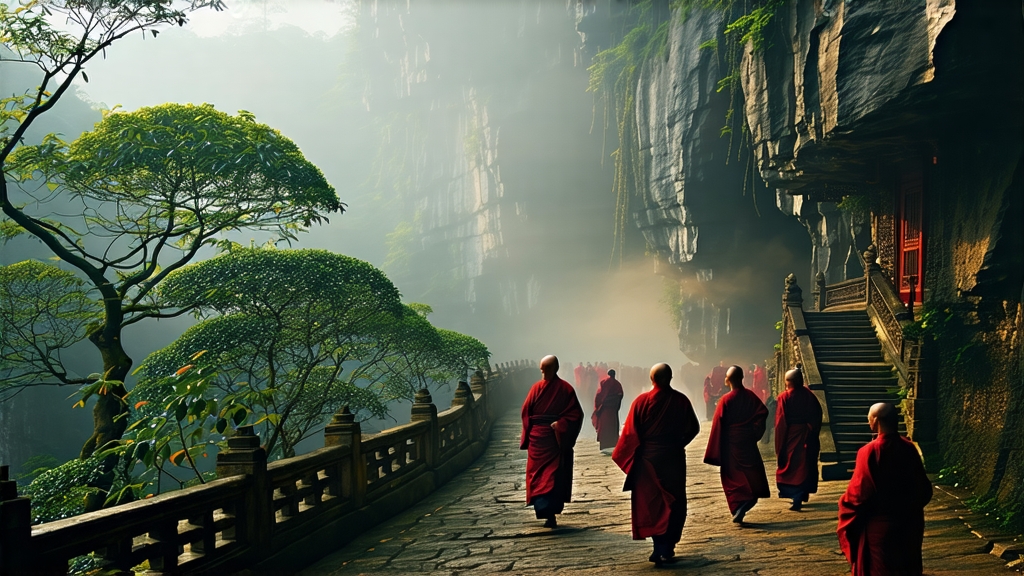
If green tea is the fresh-faced youth of Chinese teas and pu-erh the wise elder, then Da Hong Pao sits somewhere in between—an eloquent middle-aged scholar whose every sentence carries layered meaning. Known in the West as “Big Red Robe,” this legendary oolong from the Wuyi Mountains of northern Fujian has been captivating palates for more than three centuries, yet its story still feels unfinished, as though each new harvest adds another paragraph to an ever-expanding epic.
Legend meets geology in the origin myth. During the Ming dynasty, a passing imperial scholar fell violently ill on his way to the capital. Monks from the Tianxin Temple brewed leaves picked from six bushy giants clinging to a narrow ledge above the Nine-Dragon Gorge. The traveler recovered overnight, and, once he secured top honors in the palace examinations, he returned in crimson official robes to thank his saviors. He draped the scarlet silk over the bushes, declaring, “May these leaves forever wear the emperor’s cloak.” Whether history or allegory, the name stuck, and so did the aura of reverence.
Geology, however, tells a less romantic but equally compelling tale. The Wuyi range is a 550-million-year-old rift valley whose cliffs are composed of weathered igneous rock rich in iron and quartz. Over millennia, vertical fissures filled with humus carried upward by mist, creating pocket-sized terraces no wider than a monk’s walking stick. On these micro-ledges, tea roots force their way into mineral seams, absorbing calcium, magnesium, and fluoride. The stress of clinging to bare rock forces the plant to produce extra polyphenols and aromatic oils, giving Da Hong Pao its signature “yan yun” or “rock rhyme”—a tactile echo of stone that arrives minutes after you swallow, like the faint sound of a distant bell.
Strictly speaking, only the original mother trees, now protected by a state order and monitored 24 hours a day, can claim genetic authenticity. Cuttings taken in the 1980s produced the so-called “purebred” or qizhong (clonal) DHP, while open-pollinated seedlings became the more affordable commodity grade. Purists speak of three stylistic peaks: que舌 (sparrow-tongue) for light, orchid-like fragrance; zhong 舌 (middle tongue) for balanced honey and mineral; and lao 舌 (old tongue) for the deep, charcoal-laden brew that can age for decades. Each style is further shaped by three roasting cycles known as zuo huo—“playing with fire”—a process so demanding that master roasters apprentice for ten years before being allowed to handle top-grade leaf.
Harvest begins in late April when the air is thick with azalea scent and the cliffs still hold the morning chill. Only the middle three leaves are plucked, leaving the fish-leaf and bud to preserve next year’s growth. After a brief solar withering, the leaves are shaken in 1.2-meter-wide bamboo drums whose slats are spaced exactly 1.5 cm apart—wide enough for bruised edges to oxidize, narrow enough to keep the leaf intact. Oxidation is arrested at 30–40 % by a 280 °C tumble in electric woks, a modernization of the original charcoal searing that once required four men to lift a single 30-kilogram cast-iron pan. Once the leaf cools, it is rolled into the distinctive “dragonfly head, frog leg” shape, then sent to the charcoal cellar.
Here, in rooms lined with local fir ash, the tea meets the most temperamental of its craftsmen. Using only embers from fruit-tree charcoal—peach for fragrance, longan for sweetness—the roaster maintains a temperature window of 75–85 °C for eight hours, rests the tea for seven days, then repeats the cycle twice more. Between roasts the leaves are cupped, sniffed, and chewed; the master listens for a crunch whose pitch reveals residual moisture. Over-roast and the tea tastes of burnt toast; under-roast and the cliff-born minerality remains locked inside. When done correctly, the finished leaf smells of toasted sesame, black sugar, and the unmistakable scent of hot river stones after summer rain.
Water chooses its own path, but for Da Hong Pao the classic Gongfu approach still reigns supreme. Begin with soft spring water brought to a rolling 100 °C; the high temperature forces the tightly curled strips to unfurl like miniature scrolls. A 120 ml zisha